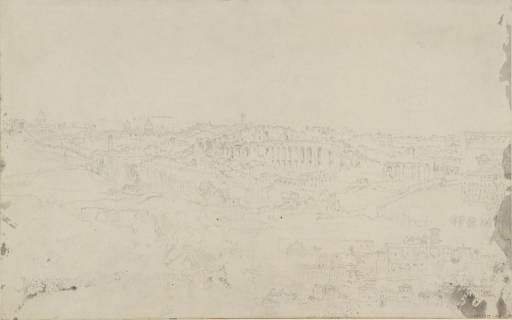Joseph Mallord William Turner View of the Palatine Hill, Rome, from Santa Balbina 1819
Joseph Mallord William Turner,
View of the Palatine Hill, Rome, from Santa Balbina
1819
Joseph Mallord William Turner 1775–1851
View of the Palatine Hill, Rome, from Santa Balbina 1819
D16348
Turner Bequest CLXXXIX 22
Turner Bequest CLXXXIX 22
Pencil and traces of grey watercolour on white wove ‘Valleyfield’ paper, 231 x 369 mm
Inscribed by the artist in pencil ‘Villa Balbina’ bottom left and ‘wall’ underneath and centre left, near left-hand edge, and ‘old wall’ centre right, underneath substrucutres of Palatine Hill
Stamped in black ‘CLXXXIX 22’ bottom right
Inscribed by the artist in pencil ‘Villa Balbina’ bottom left and ‘wall’ underneath and centre left, near left-hand edge, and ‘old wall’ centre right, underneath substrucutres of Palatine Hill
Stamped in black ‘CLXXXIX 22’ bottom right
Accepted by the nation as part of the Turner Bequest 1856
Exhibition history
1904
National Gallery, London, various dates to at least 1904 (274).
References
1904
E.T. Cook and Alexander Wedderburn (eds.), Library Edition: The Works of John Ruskin: Volume XIII: Turner: The Harbours of England; Catalogues and Notes, London 1904, no.274, pp.378, 622, as ‘Rome: The Palatine’.
1909
A.J. Finberg, A Complete Inventory of the Drawings of the Turner Bequest, London 1909, vol.I, p.562, as ‘The Palatine. 274, N.G.’.
1914
Thomas Ashby, ‘Turner in Rome – II’, Burlington Magazine, vol.25, no.134, May 1914, pp.103–4, reproduced Pl.I, B, as ‘View from Behind Sta. Balbina, near the West Corner of the Baths of Caracalla’.
1920
D[ugald] S[utherland] MacColl, National Gallery, Millbank: Catalogue: Turner Collection, London 1920, p.87.
1925
Thomas Ashby, Turner’s Visions of Rome, London and New York 1925, pp.27–8, reproduced opposite p.24 pl.22, as ‘The Palatine’.
Turner made a large number of drawings of the panoramic views of Rome visible from the heights of the Palatine Hill. In this sketch, it is the hill itself which is the subject. As indicated by the inscription in the bottom left-hand corner of the page, Turner’s location was Santa Balbina, a basilica church on the Aventine Hill, west of the Baths of Caracalla. From this location he had a good view looking north across the heart of the city and the sketches on this page record a semi-circular sweep of vision of approximately 180 degrees, from St Peter’s in the west to San Giovanni in Laterano in the east. In the centre of the composition is the Palatine Hill with the tower of the Palazzo Senatorio on the Capitol rising beyond it. Beneath the vast substructures of the palace of Septimius Severus is the Circus Maximus, flanked during Turner’s day by a line of houses which have long since been removed.1 At one end of the circus is the Torre della Moletta, whilst visible at the other is the bell-tower of Santa Maria in Cosmedin in the Forum Boarium. Visible along the horizon between the Capitol in the centre and St Peter’s and the Vatican on the far left, is the Castel Sant’Angelo, flanked by the two domes of San Giovanni dei Fiorentini and Santa Maria in Valicella. To the right of the Palatine is the square shaped Torre dei Milize, the bell-tower of Santa Francesca Romana and the Temple of Venus and Roma. Below this, the Via San Gregorio leads the eye past a surviving section of the Aqua Claudia and the Church of San Gregorio Magno al Celio towards the Arch of Constantine and the Colosseum. At this point, Turner continues the panorama in a series of smaller sketches on the bottom right-hand side of the page. These extend the view looking east and include the churches of the Caelian Hill, Santi Giovanni e Paolo, Santa Maria in Domnica, and the round Santo Stefano Rotondo. The vista is completed by the Basilica Church of San Giovanni in Laterano, in the far bottom right-hand corner.
The composition is very similar to one drawn by James Hakewill in 1817, Rome. The Palatine Hill from the Convent of St. Balbina (British School at Rome Library) which Turner would have undoubtedly known from his work on Hakewill’s Picturesque Tour, just before his 1819 trip to Rome.2 A study of a similar view from San Gregorio Magno al Celio can be found on another sheet within this sketchbook (see D16335; Turner Bequest CLXXXIX 9). During the early nineteenth century, Thomas Ashby described how the view depicted by both Hakewill and Turner was transformed by the construction of the Passeggiata Archeologica, or Zona Monumentale, a wide avenue built in the valley between the Caelian, Aventine and Palatine Hills.3
Verso:
?Blank (pasted to mount).
Nicola Moorby
July 2009
How to cite
Nicola Moorby, ‘View of the Palatine Hill, Rome, from Santa Balbina 1819 by Joseph Mallord William Turner’, catalogue entry, July 2009, in David Blayney Brown (ed.), J.M.W. Turner: Sketchbooks, Drawings and Watercolours, Tate Research Publication, December 2012, https://www

